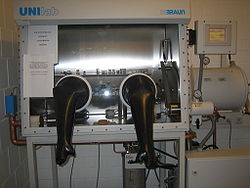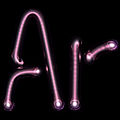Argon
Argon is a chemical element. Its symbol is argon is Ar and its atomic number is 18. It is part of the noble gas group. It is an odorless and tasteless gas. Argon is the third-most abundant gas in the Earth's atmosphere.
 | |||||||||||||||||||||||||||||||||||||||||
| General properties | |||||||||||||||||||||||||||||||||||||||||
|---|---|---|---|---|---|---|---|---|---|---|---|---|---|---|---|---|---|---|---|---|---|---|---|---|---|---|---|---|---|---|---|---|---|---|---|---|---|---|---|---|---|
| Pronunciation | /ˈɑːrɡɒn/ | ||||||||||||||||||||||||||||||||||||||||
| Appearance | colorless gas exhibiting a lilac/violet glow when placed in an electric field | ||||||||||||||||||||||||||||||||||||||||
| Standard atomic weight (Ar, standard) | [39.792, 39.963][1] | ||||||||||||||||||||||||||||||||||||||||
| Argon in the periodic table | |||||||||||||||||||||||||||||||||||||||||
| |||||||||||||||||||||||||||||||||||||||||
| Atomic number (Z) | 18 | ||||||||||||||||||||||||||||||||||||||||
| Group | group 18 (noble gases) | ||||||||||||||||||||||||||||||||||||||||
| Period | period 3 | ||||||||||||||||||||||||||||||||||||||||
| Block | p-block | ||||||||||||||||||||||||||||||||||||||||
| Element category | noble gas | ||||||||||||||||||||||||||||||||||||||||
| Electron configuration | [Ne] 3s2 3p6 | ||||||||||||||||||||||||||||||||||||||||
Electrons per shell | 2, 8, 8 | ||||||||||||||||||||||||||||||||||||||||
| Physical properties | |||||||||||||||||||||||||||||||||||||||||
| Phase at STP | Ar: Gas | ||||||||||||||||||||||||||||||||||||||||
| Melting point | 83.81 K (−189.34 °C, −308.81 °F) | ||||||||||||||||||||||||||||||||||||||||
| Boiling point | 87.302 K (−185.848 °C, −302.526 °F) | ||||||||||||||||||||||||||||||||||||||||
| Density (at STP) | 1.784 g/L | ||||||||||||||||||||||||||||||||||||||||
| when liquid (at b.p.) | 1.3954 g/cm3 | ||||||||||||||||||||||||||||||||||||||||
| Triple point | 83.8058 K, 68.89 kPa[2] | ||||||||||||||||||||||||||||||||||||||||
| Critical point | 150.687 K, 4.863 MPa[2] | ||||||||||||||||||||||||||||||||||||||||
| Heat of fusion | 1.18 kJ/mol | ||||||||||||||||||||||||||||||||||||||||
| Heat of vaporization | 6.53 kJ/mol | ||||||||||||||||||||||||||||||||||||||||
| Molar heat capacity | 20.85[3] J/(mol·K) | ||||||||||||||||||||||||||||||||||||||||
Vapor pressure
| |||||||||||||||||||||||||||||||||||||||||
| Atomic properties | |||||||||||||||||||||||||||||||||||||||||
| Oxidation states | 0 | ||||||||||||||||||||||||||||||||||||||||
| Electronegativity | Pauling scale: no data | ||||||||||||||||||||||||||||||||||||||||
| Ionization energies |
| ||||||||||||||||||||||||||||||||||||||||
| Covalent radius | 106±10 pm | ||||||||||||||||||||||||||||||||||||||||
| Van der Waals radius | 188 pm | ||||||||||||||||||||||||||||||||||||||||
| Spectral lines of argon | |||||||||||||||||||||||||||||||||||||||||
| Other properties | |||||||||||||||||||||||||||||||||||||||||
| Natural occurrence | Ar: Primordial | ||||||||||||||||||||||||||||||||||||||||
| Crystal structure | face-centered cubic (fcc) | ||||||||||||||||||||||||||||||||||||||||
| Speed of sound | 323 m/s (gas, at 27 °C) | ||||||||||||||||||||||||||||||||||||||||
| Thermal conductivity | 17.72×10−3 W/(m·K) | ||||||||||||||||||||||||||||||||||||||||
| Magnetic ordering | diamagnetic[4] | ||||||||||||||||||||||||||||||||||||||||
| Magnetic susceptibility | −19.6·10−6 cm3/mol[5] | ||||||||||||||||||||||||||||||||||||||||
| CAS Number | 7440-37-1 | ||||||||||||||||||||||||||||||||||||||||
| History | |||||||||||||||||||||||||||||||||||||||||
| Discovery and first isolation | Lord Rayleigh and William Ramsay (1894) | ||||||||||||||||||||||||||||||||||||||||
| Main isotopes of argon | |||||||||||||||||||||||||||||||||||||||||
| |||||||||||||||||||||||||||||||||||||||||
| 36 Ar and 38 Ar content may be as high as 2.07% and 4.3% respectively in natural samples. 40 Ar is the remainder in such cases, whose content may be as low as 93.6%. | |||||||||||||||||||||||||||||||||||||||||
The name "argon" is from the Greek word ἀργός meaning "lazy" or "inactive" because it does not react with other chemicals.
Chemistry
Argon atoms are found in air. About 1% of the Earth's atmosphere (the air around us) is argon. It is not toxic and it does not burn easily.[6] Not many compounds can be made from Argon. However, some compounds have been formed, like argon fluorohydride (HArF). Argon has a higher density than the gases in the atmosphere as a whole, so if a balloon is filled with argon, it would fall to the ground. This means it can be used to displace oxygen and nitrogen at the bottom of an enclosed space, so, while non-toxic, it must be handled with care.
History
Argon was first removed from air in 1894 by Lord Rayleigh and Sir William Ramsay at University College London by removing oxygen, carbon dioxide, water, and nitrogen from a sample of clean air.[7][8]
Isotopes
The main isotopes of argon found on Earth are 40Ar (99.6%), 36Ar (0.34%), and 38Ar (0.06%). The most abundant isotope of argon is 40Ar. But other planets have different isotopes of argon.[9]
Production
Argon is gotten industrially by the fractional distillation of liquid air. About 700,000 tonnes of argon are produced worldwide every year.[10][9]
40Ar is made by the decay of 40K with a half-life of 1.25 billion years by electron capture or positron emission. Because of this, it is used in knowing how old rocks are.
Uses
Argon is often used when welding steel and similar work, to push away the air around the weld, so the oxygen in the air can't join with the metal being welded. It can also be used in neon lights for a purple color. Argon is used in the poultry industry to asphyxiate birds.[11][12] Argon is sometimes used for extinguishing (ending) fires.[13]
Liquid argon is used in neutrino experiments and looking for dark matter. Argon is used to preserve food.[14] Argon is sometimes used as the propellant in aerosol cans. Argon is also used as a preservative for such products as varnish, polyurethane, and paint. Argon has been used by athletes as a doping agent and has been banned as use.[15] It is used to know how old rocks are.
Argon Media
Captioned "Argon", caricature of Lord Rayleigh in Vanity Fair, 1899
A sample of caesium is packed under argon to avoid reactions with air
Gloveboxes are often filled with argon, which recirculates over scrubbers to maintain an oxygen-, nitrogen-, and moisture-free atmosphere
Argon gas-discharge lamp forming "Ar", the symbol for argon
Related pages
Sources
- ↑ Meija, J.; Coplen, T. B.; Berglund, M.; Brand, W.A.; De Bièvre, P.; Gröning, M.; Holden, N.E.; Irrgeher, J.; Loss, R.D.; Walczyk, T.; Prohaska, T. (2016). "Atomic weights of the elements 2013 (IUPAC Technical Report)". Pure and Applied Chemistry. 88 (3): 265–91. doi:10.1515/pac-2015-0305.
{{cite journal}}: Unknown parameter|displayauthors=ignored (|display-authors=suggested) (help) - ↑ 2.0 2.1 Haynes, William M., ed. (2011). CRC Handbook of Chemistry and Physics (92nd ed.). Boca Raton, FL: CRC Press. p. 4.121. ISBN 1439855110.
- ↑ Shuen-Chen Hwang, Robert D. Lein, Daniel A. Morgan (2005). "Noble Gases". Kirk Othmer Encyclopedia of Chemical Technology. Wiley. pp. 343–383. doi:10.1002/0471238961.0701190508230114.a01.
- ↑ Magnetic susceptibility of the elements and inorganic compounds, in Lide, D. R., ed. (2005). CRC Handbook of Chemistry and Physics (86th ed.). Boca Raton (FL): CRC Press. ISBN 0-8493-0486-5.
- ↑ Weast, Robert (1984). CRC, Handbook of Chemistry and Physics. Boca Raton, Florida: Chemical Rubber Company Publishing. pp. E110. ISBN 0-8493-0464-4.
- ↑ "Universal Industrial Gases, Inc. ... MSDS Gaseous Argon - GAR". www.uigi.com. Retrieved 2021-08-29.
- ↑ "I. Argon, a new constituent of the atmosphere". Proceedings of the Royal Society of London. 57 (340–346): 265–287. 1895-12-31. doi:10.1098/rspl.1894.0149. ISSN 0370-1662. S2CID 123541469.
- ↑ "The Nobel Prize in Chemistry 1904". NobelPrize.org. Retrieved 2021-08-29.
- ↑ 9.0 9.1 Emsley, John (2011). Nature's Building Blocks : an a-Z Guide to the Elements (2nd ed.). Oxford: Oxford University Press, Incorporated. ISBN 978-0-19-257046-8. OCLC 1119634122.
- ↑ "Periodic Table of Elements: Argon - Ar (EnvironmentalChemistry.com)". environmentalchemistry.com. Retrieved 2021-08-29.
- ↑ "Slaughter technology" (PDF). 2011-07-24. Archived (PDF) from the original on 2011-07-24. Retrieved 2021-08-29.
- ↑ Shields, Sara J.; Raj, A. B. M. (2010-09-17). "A Critical Review of Electrical Water-Bath Stun Systems for Poultry Slaughter and Recent Developments in Alternative Technologies". Journal of Applied Animal Welfare Science. 13 (4): 281–299. doi:10.1080/10888705.2010.507119. ISSN 1088-8705. PMID 20865613. S2CID 11301328.
- ↑ Su, Joseph Z.; Kim, Andrew K.; Crampton, George P.; Liu, Zhigang (2001-05-01). "Fire Suppression with Inert Gas Agents". Journal of Fire Protection Engineering. 11 (2): 72–87. doi:10.1106/X21V-YQKU-PMKP-XGTP.[dead link]
- ↑ Ilouga, Pierre E.; Winkler, Dirk; Kirchhoff, Christian; Schierholz, Bernd; Wölcke, Julian (2007). "Investigation of 3 Industry-Wide Applied Storage Conditions for Compound Libraries". Journal of Biomolecular Screening. 12 (1): 21–32. doi:10.1177/1087057106295507. ISSN 1087-0571. PMID 17099243. S2CID 23750770.
- ↑ "Newsroom". World Anti-Doping Agency. Archived from the original on 2021-04-27. Retrieved 2021-08-29.









